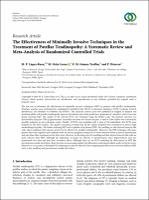Por favor, use este identificador para citar o enlazar este ítem:
https://repositorio.usj.es/handle/123456789/454
| Título : | The Effectiveness of Minimally Invasive Techniques in the Treatment of Patellar Tendinopathy: A Systematic Review and Meta-Analysis of Randomized Controlled Trials |
| Autor: | López-Royo, María Pilar


Ortiz Lucas, María 
Gómez-Trullén, Eva María 

Herrero Gállego, Pablo 


|
| Palabras clave : | Técnicas mínimamente invasivas |
| Fecha de publicación: | 7-sep-2020 |
| Editorial : | Hindawi Limited |
| Citación : | López-Royo MP, Ortiz-Lucas M, Gómez-Trullén EM, Herrero P. The Effectiveness of Minimally Invasive Techniques in the Treatment of Patellar Tendinopathy: A Systematic Review and Meta-Analysis of Randomized Controlled Trials. Evid Based Complement Alternat Med. 2020 Sep 5;2020:8706283. doi: 10.1155/2020/8706283. |
| Resumen : | The aim was to determine the effectiveness of minimally invasive techniques (MIT) in patients with patellar tendinopathy. Database searches were performed for randomized controlled trials (RCTs) in electronic databases (WOS, Cochrane Central, SportDiscus, and Medline via PubMed and PEDro). The inclusion criteria used were published in English or Spanish and involving adults with patellar tendinopathy (pain on the inferior pole of the patella for a minimum of 3 months), with at least one group receiving MIT. The quality of the relevant RCTs was evaluated using the PEDro scale. The primary outcome was functionality using the VISA-p questionnaire. Secondary outcome was focused on pain. A total of 1164 studies were screened for possible inclusion in our systematic review. Finally, 10 RCTs were included with a total of 326 individuals. Five RCTs were included in the meta-analysis. The quality assessment revealed that all the studies included were considered to possess high methodological quality. All studies analyzing MIT such as platelet-rich plasma (PRP), dry needling, or skin-derived tenocyte-like cells, when combined with exercise, proved to be effective for patellar tendinopathy. Moreover, the PRP technique with doses greater than 4 mL together and combined with an exercise program lasting over 6 weeks obtained better results in functionality and pain than other treatments in the short term. However, in the long term, dry needling and skin-derived tenocyte-like cells are more effective than PRP. Although the infiltration of drugs was effective at posttreatment, these improvements were not maintained over time and may have secondary effects. Although there are no RCTs analyzing the effectiveness of MIT like percutaneous needle electrolysis, there has been an increasing number of publications achieving excellent results in the last years. However, it is necessary to develop RCTs analyzing not only the effect but also comparing the effectiveness between different MIT such as dry needling and percutaneous needle electrolysis. |
| URI : | https://repositorio.usj.es/handle/123456789/454 |
| ISSN : | 1741-427X |
| Aparece en las colecciones: | Artículos de revistas |
Ficheros en este ítem:
| Fichero | Descripción | Tamaño | Formato | |
|---|---|---|---|---|
| The Effectiveness of Minimally Invasive Techniques in the Treatment of Patellar Tendinopathy.pdf | 1,59 MB | Adobe PDF |  Visualizar/Abrir |
Este ítem está sujeto a una licencia Creative Commons Licencia Creative Commons

